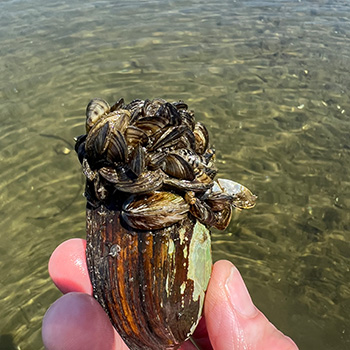CLF is working to address the threats to Lake Champlain and waterways across New England, including:
Toxic Blue-Green Algae (Cyanobacteria) Outbreaks
Phosphorus and nitrogen have impaired Lake Champlain. Washing off farm fields, roads, parking lots, and eroded stream banks, these nutrients enter the lake and overfeed algal populations, resulting in toxic blue-green algae (cyanobacteria) outbreaks that kill water wildlife. These outbreaks also lead to beach closures because of the public health implications. Certain toxins produced by blue-green algae cause diarrhea, vomiting, and liver damage. Emerging research has also linked toxic blue-green algae with neurological diseases including amyotrophic lateral sclerosis (ALS) and Parkinson’s.
Dock Foam
Many floating docks along Lake Champlain (and throughout New England) are made from polystyrene foam. This “dock foam” breaks apart into large and small pieces, polluting our shores, trashing our beaches, and threatening the health of animals who call our waters home. This plastic foam pollutes our drinking water supply and the fish we catch. When fish and other wildlife mistake small pieces of dock foam for food, it harms their digestive system, becoming a significant source of microplastics in fish caught in the lake.
Sewage Overflow
Every year, gallons of sewage are released into Vermont’s waterways from wastewater treatment facilities. The Vermont Department of Environmental Conservation has created a Waste Water Inventory that tracks these overflow events. Heavy rains can overwhelm combined sewer systems, which collect industrial wastewater, domestic sewage, and rainwater in the same pipe, causing the release of wastewater directly into nearby water bodies. This wastewater can contain untreated human and industrial waste, toxic materials, and debris, contributing to the already-high phosphorus loads in Lake Champlain.
Aquatic Invasive Species
Invasive species such as zebra mussels, spiny water flea, sea lamprey, Eurasian watermilfoil, and water chestnut harm Lake Champlain. In the absence of ecological controls, such as disease and predators, these non-native species can out-compete natives and deplete the lake’s native biodiversity, impair water quality, and destroy habitat. What’s more aquatic invasive species damage human health, devastate the economy, and interfere with recreation. They can also impact drinking water systems, threaten fisheries, and reduce property values.



